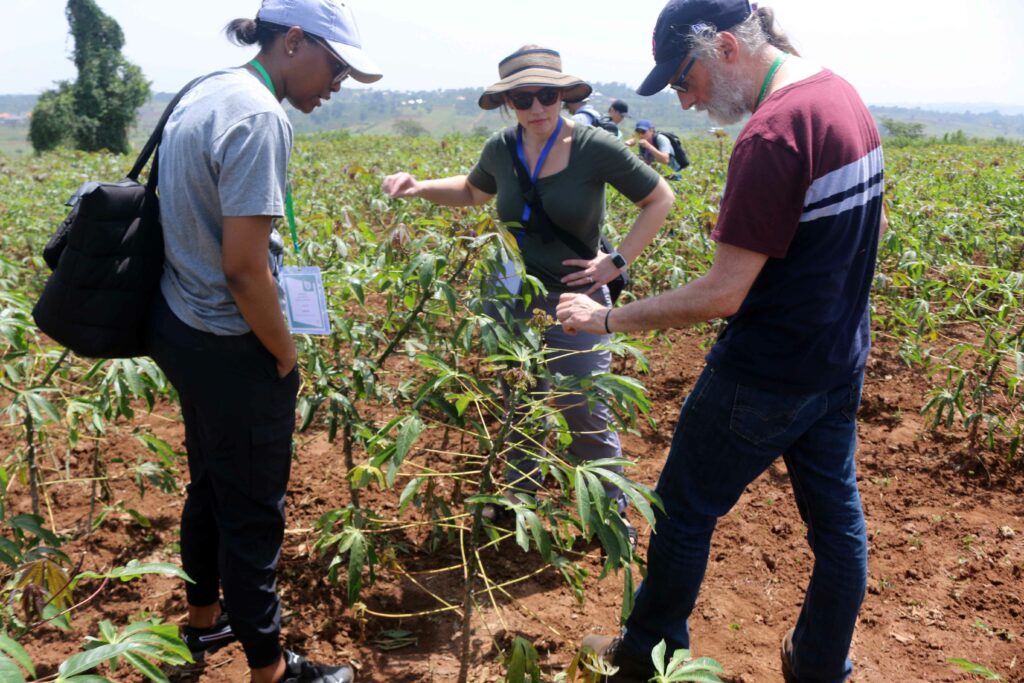By Agnes Nantambi
Researchers at the National Agricultural Resources Research Institute (NaCRRI) have committed themselves towards improving the cassava seed system in Uganda.
According to Gerald Adiga, a research officer working on cassava seed systems at the root crop program based at the NaCRRI explain that,
“When we talk of cassava seed system, we are talking about the stem cutting, because crops like cassava, sweat potatoes and yams are propagated by vegetative means and specifically for cassava we propagate it using stem cuttings which are called the seeds,”
In Uganda he said cassava seed systems is something that has not been taken up by seed companies just because the stem cuttings are perishable, cannot last for long yet at the same times they are bulky.
“One of the big challenges we are having with cassava is the biotic stress in terms of cassava diseases especially the cassava mosaic and cassava brown streak diseases.
Both diseases are caused by a virus and NARO through science and breeding, has tried to fix the problem of cassava mosaic disease by developing resistant varieties that are not attacked by the diseases although the problem of cassava brown streak disease still remains,

This is because the varieties we have are just tolerant varieties but we don’t have complete resistance to cassava brown streak disease, “he said
Because of this he said the seed system of cassava generally in the country has been informal where one goes to the neighbor and get planting material and plants without assessing whether the materials have a virus or not.
This according to him, is because the farmer’s knowledge on the diseases is not so much, something he said has perpetuated the diseases which has in turn led to a reduction in yields in cassava.
In an effort to address this NARO he said came up with an effort in 2013 and got funds from the bill and Merida gates foundation to pilot the first cassava seed systems project in Uganda to address the informal cassava seed sector.
Under this he said, they identified the cassava seed entrepreneurs who must have land and willingness to do that.
“Through the cassava seed entrepreneurs, we were able to get breeder seed from Namulonge and made the farmers multiply these seeds in clean environment that is certified by the MAAIF through the National seed certification sector of the ministry.
As a result of this, we were able to shun out a lot of improved varieties which are high yielding and which are tolerant and resistant to the diseases we are talking about, “he said.
He however said the project which ran from 2013-2016 ended and picking from where it ended, has been a tag of war although the seed entrepreneurs have remained active but the system have not been streamlined.
“Despite the project ending, this has done a lot in improving and increasing the production of cassava in the country.
As we speak now, we have about 80% of improved varieties from NARO grown in the country, “he said.
Adiga cited degeneration as one of the major challenges faced saying since the varieties are not very resistant to the cassava brown streak disease, over time they succumb to the disease.
“When you give the farmer and has oven recycled the variety for five years, you might find the challenges of brown streak diseases and the rest.
In order to fix this, we need to shun in new varieties in form of releases at the same time shun out new clean planting materials.
He explained that seed systems, normally has seed classes, the first being the Prebasic seed which begin with in the lab as tissue culture material.
“The first thing is picking the varieties from the field and clean them against viruses through different methods in the lab to ensure that the viruses are not there, then through tissue culture you grow them and hardened them and know that the set of planting materials you are having are free from virus.
This set of plants from the tissue culture are then planted in a low disease pressure area like Kiryandongo, fort portal for multiplication and after multiplying them in the pre-basic seed, we now go to next seed class which is a basic seed.
At the basic seed, he explained that they identify large scale seed entrepreneurs who are able to adhere to the standards operating procedures put out by NARO to multiply the seeds and one of the very important things is to look at the isolation distance from any cassava garden.
“Once everything is adhered to, we multiply it as a basic seed and make it accessible to the cassava seed entrepreneurs who pick it from NARO and go and multiply it as a certified seed because they were monitored by the MAAIF and NARO to ensure that the SOPs are observed and have no disease infection.
When this is done and they are given certification number by MAAF, they are then allowed to supply to farmers and other NGOs and this has led to increased cassava production in the country up to 30tons per hectare,” he said.
He emphasizes that clean seed coupled with good agronomic practices lead to high yields in cassava.





